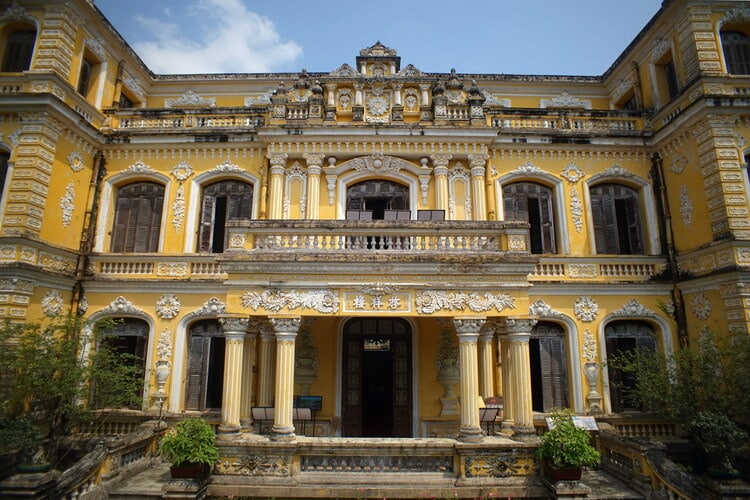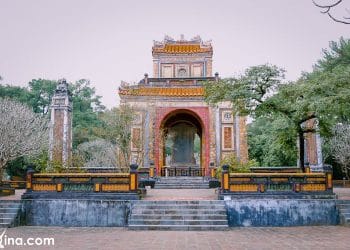Contents
The trip to Hue, the former capital of Vietnam will be incomplete if you ignore An Định palace – the pearl with a hundred year of history. Coming to this palace, tourists can admire and explore the beautiful, mostly undamaged structures in the harmony of modern-ancient architecture.
Location:
An Định palace is located on the riverside of An Cựu River, Đệ Bát ward, Huế town (now at 97 Phan Dinh Phung street, Hue city). It was initially the imperial palace of Khai Dinh King when he was the prince until he became the emperor. After that, Bao Dai inherited and lived there until he abdicated the throne.
History:

Initially, Nguyen Phuc Buu Dao (or Khai Dinh King) built his private palace named An Dinh from the 14th year of Thanh Thai emperor (1902). After enthroning in 1917, Khai Dinh spent money in restoring the palace in modern style. At the beginning of 1919, the construction work was completed, the palace still kept the same name. From February 28th 1922, An Dinh palace became the foundation of Vinh Thuy crown prince’s residence (Bao Dai King). After the August Revolution in 1945, the royal family of Bao Dai King moved from the royal palace to An Dinh palace. After 1954, Ngo Dinh Diem government seized the palace. Until 1975, Từ Cung (the Queen Mother Đoan Huy) gave An Dinh palace for the revolutionary government to become the tenement house for Hue University’s professors. This palace was seriously downgraded, until 2001 the authority carried out the restoration and repair. Six mural paintings in Khải Tường pavillion, by the support of Federal Republic of Germany, was reverted in the original state and applied preservative substances to avoid environmental effects. This helps An Dinh palace recover its appearance.
Architecture:

An Dinh palace is toward the south of An Cuu River. Being a flatly situated palace, An Dinh had the area of 23463m2 and was circled by the brick campus with the thickness of 0.5m, the height of 1.8m. In the undamaged state, the palace had around ten structures including the pier, the main gate, Trung Lap communal house, Khai Tuong Pavilion, Cửu Tư Đài theatre, animal cage/small zoo, lake.
Remarkably, Cuu Tu Dai theatre was highly appreciated for its luxurious and magnificent structure and interior decoration. With the total area of 1200m2, Cuu Tu Dai was located on Khai Tuong pavilion. The theatre was spacious and could contain about 500 people. Unfortunately, Cuu Tu Dai was completely damaged in 1947.
Through time and damage caused by wars, the palace has had three mostly intact structures: the main gate, Trung Lap communal house and Khai Tuong pavilion. The main entrance was designed in the three-gate style with two floors and decorated by meticulously embossed porcelain. Trung Lap communal house inside the gate was designed as the octagonal communal house with the high basement. The statue of Khai Dinh King in original scale casted in 1920 was placed in the communal house.
Khai Tuong Pavilion, the main architecture of An Dinh palace, lies on the back of Trung Lap communal house. The word “Khai Tuong” means “the place to spread blessings” which was named by Khai Dinh King. The third floor was built with modern materials according to European castle with the area of 745m2. The pavilion was decorated sophisticatedly; especially the walls of the interior part of the 1st floor were hung on mural paintings with the art values.
Read more: Hon Chen Palace – A Harmony Of Cultural Features In Hue
Architectural Value:

Built at the same period as Khai Dinh palace, Kien Trung pavilion, Hien Nhon gate, An Dinh palace was considered the iconic feature of Vietnamese architecture in the modern-ancient period (Néo – Classique). Therefore, it opened the period when Vietnamese architecture was influenced by Western style. Most of the structures in An Dinh palace were the association of themes between traditional Vietnamese decoration and European decoration, which creates a unique architecture with distinctive features. Typically, the design of An Dinh palace was blended among traditional decoration featuring the four animals, the four seasons, eight precious things and stylized patterns of Roman style like stars and angels.
In the harmony of Western and Oriental architecture, An Dinh Palace bears great points in each layout of the structure. Overseeing the undamaged architectures, tourists can feel the talent and creativity of engineers. Besides, the palace was a reflection of modern fine-art decoration that became the trend later.
It will be such a wonderful trip for tourists to explore and learn the history of An Dinh palace, Hue. The undamaged architectures are attractive to people who are eager to find out about the Nguyen Dynasty and architectural values of European and traditional Vietnamese style.
By Minh Phuong















